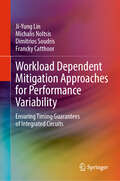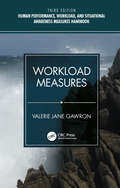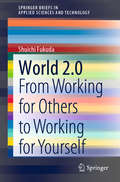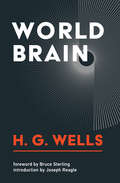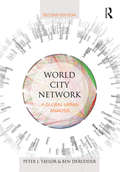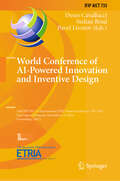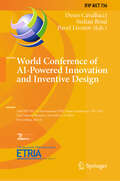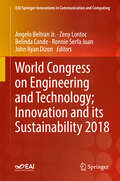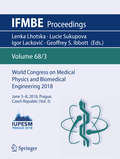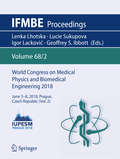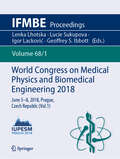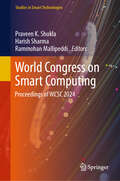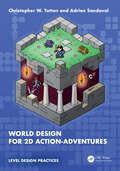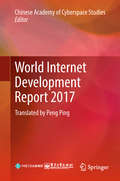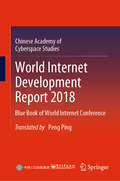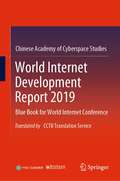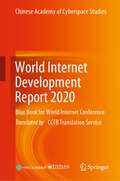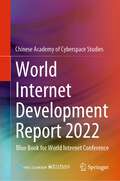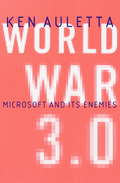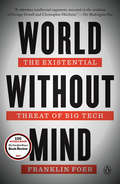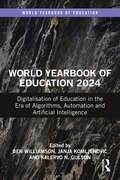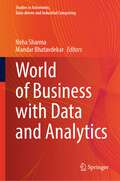- Table View
- List View
Workload Dependent Mitigation Approaches for Performance Variability: Ensuring Timing Guarantees of Integrated Circuits
by Dimitrios Soudris Francky Catthoor Ji-Yung Lin Michalis NoltsisThis book provides a holistic view of workload-dependent mitigation techniques for performance variability. The authors describe the use of design-time profiling information to reduce the uncertainties in future execution time calculation at run time, thereby offering the best option for minimizing system costs while reducing missed deadlines. Readers are introduced to an approach that combines dynamic voltage and frequency scaling (DVFS) with heterogeneous datapaths (HDP), enabling users to tackle performance variability of multiple timescales down to the sub-millisecond level.
Workload Measures
by Valerie Jane GawronThis book was developed to help researchers and practitioners select measures to be used in the evaluation of human/machine systems. The book includes definitions of human workload and a review of measures. Each measure is described, along with its strengths and limitations, data requirements, threshold values, and sources of further information. To make this reference easier to use, extensive author and subject indices are provided. Features Offers readily accessible information on workload measures Presents general description of the measure Covers data collection, reduction, and analysis requirements Details the strengths and limitations or restrictions of each measure, including proprietary rights or restrictions Provides validity and reliability data as available
Workload Modeling for Computer Systems Performance Evaluation
by Dror G. FeitelsonReliable performance evaluations require the use of representative workloads. This is no easy task since modern computer systems and their workloads are complex, with many interrelated attributes and complicated structures. Experts often use sophisticated mathematics to analyze and describe workload models, making these models difficult for practitioners to grasp. This book aims to close this gap by emphasizing the intuition and the reasoning behind the definitions and derivations related to the workload models. It provides numerous examples from real production systems, with hundreds of graphs. Using this book, readers will be able to analyze collected workload data and clean it if necessary, derive statistical models that include skewed marginal distributions and correlations, and consider the need for generative models and feedback from the system. The descriptive statistics techniques covered are also useful for other domains.
World 2.0: From Working for Others to Working for Yourself (SpringerBriefs in Applied Sciences and Technology)
by Shuichi FukudaThis book explores on how the Internet of Things (IoT) will change society by bringing living and non-living things together. The IoT is currently attracting considerable attention, but most of the discussions focus on engineering aspects alone. The IoT, however, is not an extension of traditional engineering, where humans and machines are separated. Instead it connects humans and machines, enabling them to work together as a team: the IoT Connected Society.In traditional engineering, our knowledge and experience of physical and non-living things plays a key role, but such knowledge and experience alone are not enough. We need to introduce life science approaches and integrate them into physical science to really develop the IoT connected society.In addition, the Internet is not only a tool for delivering messages: it is a broader communication tool. In the IoT connected society, living things and non-living things communicate in complex ways. Machines 1. Introduction2. Emerging Industrial Revolution3. IoT: What makes it different from the past revolutions4. World is changing5. Engineering: How It was developed so far6. Humans: Their characteristics7. Value is changing8. Adaptive team organization and management9. Integration of Physical Science and Life Science10. Summary can provide humans with a improved situational awareness and advice, and together they can communicate to develop a better, happier society. Thus, this book makes the case that to make the IoT connected society a reality, we need to integrate the physical and life sciences and develop a new science for the next generation of engineering.
World Brain
by H.G. WellsIn 1937, H. G. Wells proposed a predigital, freely available World Encyclopedia to represent a civilization-saving World Brain.In a series of talks and essays in 1937, H. G. Wells proselytized for what he called a "World Brain," as manifested in a World Encyclopedia--a repository of scientifically established knowledge--that would spread enlightenment around the world and lead to world peace. Wells, known to readers today as the author of The War of the Worlds and other science fiction classics, was imagining something like a predigital Wikipedia. The World Encyclopedia would provide a summary of verified reality (in about forty volumes); it would be widely available, free of copyright, and utilize the latest technology. Of course, as Bruce Sterling points out in the foreword to this edition of Wells's work, the World Brain didn't happen; the internet did. And yet, Wells anticipated aspects of the internet, envisioning the World Brain as a technical system of networked knowledge (in Sterling's words, a "hypothetical super-gadget"). Wells's optimism about the power of information might strike readers today as naïvely utopian, but possibly also inspirational.
World City Network: A Global Urban Analysis
by Peter J. Taylor Ben DerudderWith the advent of multinational corporations, the traditional urban service function has 'gone global'. In order to provide services to globalizing corporate clients, the offices of major financial and business service firms across the world have formed a network. It is the myriad of flows between office towers in different metropolitan centres that has produced a world city network. Through an analysis of the intra-company flows of 100 leading global service firms across 315 cities, this book assesses cities in terms of their overall network connectivity, their connectivity by service sector, and their connectivity by world region. Peter Taylor's unique and illuminating book provides the first comprehensive and systematic description and analysis of the world city network as the 'skeleton' upon which contemporary globalization has been built. His analyses challenge the traditional view of the world as a 'mosaic map' of political boundaries. Written by one of the foremost authorities on the subject, this book provides a much needed mapping of the connecting relationships between world cities, and will be an enlightening book for students of urban studies, geography, sociology and planning.
World City Network: A global urban analysis
by Peter J. Taylor Ben DerudderWith the advent of multinational corporations, the traditional urban service function has 'gone global'. In order to provide services to globalizing corporate clients, the offices of major financial and business service firms across the world have generated networks of work. It is the myriad of flows between office towers in different metropolitan centres that has produced a world city network. Taylor and Derudder's unique and illuminating book provides both an update and a substantial revision of the first edition that was published in 2004. It provides a comprehensive and systematic description and analysis of the world city network as the 'skeleton' upon which contemporary globalization has been built. Through an analysis of the intra-company flows of 175 leading global service firms across 526 cities in 2012, this book assesses cities in terms of their overall network connectivity, the regional configurations they form, and their changing position in the period 2000-12. Results are used to reflect on cities and city/state relations in the context of the global ecological and economic crisis. Written by two of the foremost authorities on the subject, this book provides a much-needed mapping of the connecting relationships between world cities, and will be a valuable resource for students of urban studies, geography, sociology and planning.
World Conference of AI-Powered Innovation and Inventive Design: 24th IFIP WG 5.4 International TRIZ Future Conference, TFC 2024, Cluj-Napoca, Romania, November 6–8, 2024, Proceedings, Part I (IFIP Advances in Information and Communication Technology #735)
by Denis Cavallucci Stelian Brad Pavel LivotovThis book constitutes the proceedings of the 24th IFIP WG 5.4 International TRIZ Future Conference on AI-Powered Innovation and Inventive Design, TFC 2024, held in Cluj-Napoca, Romania, during November 6–8, 2024. The 42 full papers presented were carefully reviewed and selected from 72 submissions. They were organized in the following topical sections: Part I - AI-Driven TRIZ and Innovation Part II - Sustainable and Industrial Design with TRIZ; Digital Transformation, Industry 4.0, and Predictive Analytics; Interdisciplinary and Cognitive Approaches in TRIZ; Customer Experience and Service Innovation with TRIZ.
World Conference of AI-Powered Innovation and Inventive Design: 24th IFIP WG 5.4 International TRIZ Future Conference, TFC 2024, Cluj-Napoca, Romania, November 6–8, 2024, Proceedings, Part II (IFIP Advances in Information and Communication Technology #736)
by Denis Cavallucci Stelian Brad Pavel LivotovThis book constitutes the proceedings of the 24th IFIP WG 5.4 International TRIZ Future Conference on AI-Powered Innovation and Inventive Design, TFC 2024, held in Cluj-Napoca, Romania, during November 6–8, 2024. The 42 full papers presented were carefully reviewed and selected from 72 submissions. They were organized in the following topical sections: Part I - AI-Driven TRIZ and Innovation Part II - Sustainable and Industrial Design with TRIZ; Digital Transformation, Industry 4.0, and Predictive Analytics; Interdisciplinary and Cognitive Approaches in TRIZ; Customer Experience and Service Innovation with TRIZ.
World Congress on Engineering and Technology; Innovation and its Sustainability 2018 (EAI/Springer Innovations in Communication and Computing)
by Angelo Beltran Jr. Zeny Lontoc Belinda Conde Ronnie Serfa Juan John Ryan DizonThe book presents the proceedings of the World Congress on Engineering and Technology, Innovation and its Sustainability (WCETIS 2018), which took place on November 28-29, 2018 in Manila, Philippines. The conference featured the following tracks: Industrial Engineering and Healthcare, Sustainable Infrastructure; Water Resources Planning and Management; Heat transfer and fluids; Electronics and Electrical Engineering; and Internet of Things. Papers stem from academia and industry throughout the world, showing a variety of perspectives.Presents the proceedings of the World Congress on Engineering and Technology, Innovation and its Sustainability (WCETIS 2018), November 28-29, 2018 in Manila, PhilippinesShows how engineering and technology serve to support a variety for industries from manufacturing to water resourcesFeatures papers from a variety of researchers and developers from around the world
World Congress on Medical Physics and Biomedical Engineering 2018: June 3-8, 2018, Prague, Czech Republic (vol. 2) (IFMBE Proceedings #68/2)
by Geoffrey S. Ibbott Lenka Lhotska Lucie Sukupova Igor LackovićThis book (vol. 3) presents the proceedings of the IUPESM World Congress on Biomedical Engineering and Medical Physics, a triennially organized joint meeting of medical physicists, biomedical engineers and adjoining health care professionals. Besides the purely scientific and technological topics, the 2018 Congress will also focus on other aspects of professional involvement in health care, such as education and training, accreditation and certification, health technology assessment and patient safety. The IUPESM meeting is an important forum for medical physicists and biomedical engineers in medicine and healthcare learn and share knowledge, and discuss the latest research outcomes and technological advancements as well as new ideas in both medical physics and biomedical engineering field.
World Congress on Medical Physics and Biomedical Engineering 2018: June 3-8, 2018, Prague, Czech Republic (vol. 2) (IFMBE Proceedings #68/2)
by Geoffrey S. Ibbott Lenka Lhotska Lucie Sukupova Igor LackovićThis book (vol. 2) presents the proceedings of the IUPESM World Congress on Biomedical Engineering and Medical Physics, a triennially organized joint meeting of medical physicists, biomedical engineers and adjoining health care professionals. Besides the purely scientific and technological topics, the 2018 Congress will also focus on other aspects of professional involvement in health care, such as education and training, accreditation and certification, health technology assessment and patient safety. The IUPESM meeting is an important forum for medical physicists and biomedical engineers in medicine and healthcare learn and share knowledge, and discuss the latest research outcomes and technological advancements as well as new ideas in both medical physics and biomedical engineering field.
World Congress on Medical Physics and Biomedical Engineering 2018: June 3-8, 2018, Prague, Czech Republic (vol. 2) (IFMBE Proceedings #68/2)
by Geoffrey S. Ibbott Lenka Lhotska Lucie Sukupova Igor LackovićThis book (vol. 1) presents the proceedings of the IUPESM World Congress on Biomedical Engineering and Medical Physics, a triennially organized joint meeting of medical physicists, biomedical engineers and adjoining health care professionals. Besides the purely scientific and technological topics, the 2018 Congress will also focus on other aspects of professional involvement in health care, such as education and training, accreditation and certification, health technology assessment and patient safety. The IUPESM meeting is an important forum for medical physicists and biomedical engineers in medicine and healthcare learn and share knowledge, and discuss the latest research outcomes and technological advancements as well as new ideas in both medical physics and biomedical engineering field.
World Congress on Smart Computing: Proceedings of WCSC 2024 (Studies in Smart Technologies)
by Harish Sharma Rammohan Mallipeddi Praveen K. ShuklaThis book is a collection of the high-quality research articles in the field of machine learning, big-data analytics, computer vision, cloud computing, artificial intelligence, intelligent system, soft computing, and their real-world applications. The papers are presented at World Congress on Smart Computing (WCSC 2024), held during June 8–9, 2024, at Artificial Intelligence Research Center, Babu Banarasi Das University, Lucknow, India.
World Design for 2D Action-Adventures (Level Design Practices)
by Christopher W. Totten Adrian SandovalAward-winning action-adventure designers Christopher Totten and Adrian Sandoval guide you on a quest to create levels for different styles of 2D action-adventure games, from top-down dungeon-crawler adventures to side-scrolling non-linear “Metroidvania” titles. Blending theory and practical analysis, this book shows how principles of game and level design are applied in some of your favorite 2D action-adventure games. It uses examples from popular games such as The Legend of Zelda and Hollow Knight, while also providing insights from the authors’ own experiences creating independent games in the genre.This book also intersperses these examples with practical exercises in 2D action-adventure world design using the free and easy-to-use GB Studio engine, allowing readers to practice their skills and see how lessons from the theory chapters apply in real game development environments. These practical chapters cover the basics of using GB Studio and related software, such as Aseprite and Tiled, to help readers create their own action-adventure characters, monsters, quest systems, switches, keys, and other mechanics - all the way up to designing their own dungeon!World Design for 2D Action-Adventures will be of great interest to all those looking to improve their level design skills within this genre.
World Internet Development Report 2017: Translated by Peng Ping
by Chinese Academy of Cyberspace StudiesAn important outcome of the Fourth World Internet Conference, this book provides a comprehensive account of the status quo and trends in global Internet development. Covering network infrastructure, information technology, digital economy, e-governance, cyber security, and international cyberspace governance, it presents the Global Internet Development Index System to assess the Internet development of various major countries and emerging economies.
World Internet Development Report 2018: Blue Book of World Internet Conference
by Chinese Academy of Cyberspace StudiesThis book is an important outcome of the Fifth World Internet Conference. It provides a comprehensive account of the new trends and highlights of global Internet development over the past year, covering network infrastructure, information technology, digital economy, world internet media, cyber security, and international cyberspace governance. This year, the book improves the Global Internet Development Index System and adds more countries into the assessed list, in order to reflect more comprehensively, objectively and accurately the general situation of the world Internet development and thus to provide reference for all countries in promoting Internet development and governance.
World Internet Development Report 2019: Blue Book for World Internet Conference, Translated by CCTB Translation Service
by Chinese Academy of Cyberspace StudiesThis book systematically reviews world Internet development over the past 50 years, and comprehensively discusses the great contributions it has made to economic and social advances. Further, it describes the development, status and trends related to the Internet in major countries around the globe in 2019, and provides an in-depth analysis of the latest conditions, dynamics and development trends in key areas, including information infrastructure, information technology, digital economy, digital government, Internet media, cyberspace security, and international cyberspace governance. Moreover, the book further modifies and enhances the Global Internet Development Index System, in order to better show the Internet development strengths and advantages in various countries, and to reflect the global development trends more comprehensively, accurately and objectively. This book reviews the significant developments and summarizes the lessons learned as well as the future challenges. From a global perspective, it offers a vision of building a community with a shared future in cyberspace based on the new concepts, new ideas and new achievements of various countries participating in cyberspace development and construction. As such it is a valuable reference resource for anyone working in Internet related fields, such as those in government departments, internet enterprises, scientific research institutions, colleges and universities wanting to fully understand world Internet development.
World Internet Development Report 2020: Blue Book for World Internet Conference
by Chinese Academy of Cyberspace StudiesThis book systematically reviews the development process of the world Internet and comprehensively reveals the great contributions of the Internet to economic development and social progress. The world today is marked by changes unseen in a century, and Internet development is facing new opportunities and challenges. In 2020, the COVID-19 epidemic broke out and spread at the global scale, which enormously impacted the global economy and society. Internet played an increasingly important role.Meanwhile, based on the development status of the global Internet, this book fully reflects the development process, status and trend of the world Internet in 2020, systematically summarizes the development status and highlights of the Internet in the major countries around the world, and makes an in-depth analysis of the new conditions, new dynamics and new trends of the development in the key Internet fields; the contents cover the information infrastructure, information technology, digital economy, digital government, internet media, network security, and international cyberspace governance, and other aspects. Moreover, this book further adjusts and enriches the development index systems of the world Internet, in the hope of better showing the development strength and development advantages of the Internet in various countries, and reflecting the overall development trend of the world Internet more comprehensively, accurately and objectively.From an objective perspective, this book collects the latest research results in the global internet field, featuring comprehensive contents and highlights; from a historical perspective, this book reviews the significant development process of the global internet, summarizes the experience and faces the future; from a global perspective, this book tries to construct the cyberspace community with a common future based on the new concepts, new ideas and new achievements of various countries in participating in cyberspace development and construction. This book provides an important reference value for employees in Internet fields, such as government departments, Internet enterprises, scientific research institutions, colleges and universities, to fully understand and master the development of the world internet.
World Internet Development Report 2021: Blue Book for World Internet Conference
by Publishing House of Electronics IndustryThis book objectively represents the status quo and trends of world Internet development in 2021, systematically summarizes Internet development in major countries and regions, and deeply analyzes new development condition and trends in key fields of Internet, in terms of eight aspects, i.e., information infrastructure, information technology, digital economy, e-government, cyber media, cybersecurity, cyber laws, and international cyberspace governance. This book maintains the index system of world Internet development, optimizes some indexes, and comprehensively evaluates Internet development in major countries and regions in the world, in order to better demonstrate the strength and characteristics of Internet development in various countries and mirror the overall trend in world Internet development in a comprehensive, accurate, and objective way.This book collects the latest research results in world Internet development. With diverse subjects and detailed discussion, this book possesses great significance for these engaged in Internet field in governmental departments, Internet enterprises, scientific research institutions, and universities, who hope to fully understand world Internet development.
World Internet Development Report 2022: Blue Book for World Internet Conference
by Publishing House of Electronics IndustryThis book objectively presents the status quo and trends of world Internet development in 2022, systematically summarises Internet development in major countries and regions, and deeply analyses new development conditions and trends in key areas of the Internet in terms of eight aspects, i.e. information infrastructure, information technology, digital economy, e-government, cybermedia, cybersecurity, cyberlaw and international cyberspace governance. This book maintains the index system of world Internet development, optimises some indexes, and comprehensively evaluates Internet development in major countries and regions of the world, in order to better show the strength and characteristics of Internet development in various countries and reflect the overall trend of world Internet development in a comprehensive, accurate and objective way.This book collects the latest research results on the world Internet development. With diverse topics and in-depth discussions, this book is of great significance to those involved in the Internet field in government departments, Internet companies, scientific research institutions and universities who hope to fully understand the world's Internet development.
World War 3.0: Microsoft and Its Enemies
by Ken AulettaThe Internet Revolution, like all great industrial changes, has made the world's elephantine media companies tremble that their competitors--whether small and nimble mice or fellow elephants--will get to new terrain first and seize its commanding heights. In a climate in which fear and insecurity are considered healthy emotions, corporate violence becomes commonplace. In the blink of an eye--or the time it has taken slogans such as "The Internet changes everything" to go from hyperbole to banality--"creative destruction" has wracked the global economy on an epic scale. No one has been more powerful or felt more fear or reacted more violently than Bill Gates and Microsoft. Afraid that any number of competitors might outflank them--whether Netscape or Sony or AOL Time Warner or Sun or AT&T or Linux-based companies that champion the open-source movement or some college student hacking in his dorm room--Microsoft has waged holy war on all foes, leveraging its imposing strengths. In World War 3.0, Ken Auletta chronicles this fierce conflict from the vantage of its most important theater of operations: the devastating second front opened up against Bill Gates's empire by the United States government. The book's narrative spine is United States v. Microsoft, the government's massive civil suit against Microsoft for allegedly stifling competition and innovation on a broad scale. With his superb writerly gifts and extraordinary access to all the principal parties, Ken Auletta crafts this landmark confrontation into a tight, character- and incident-filled courtroom drama featuring the best legal minds of our time, including David Boies and Judge Richard Posner. And with the wisdom gleaned from covering the converging media, software, and communications industries for The New Yorker for the better part of a decade, Auletta uses this pivotal battle to shape a magisterial reckoning with the larger war and the agendas, personalities, and prospects of its many combatants.
World Without Mind: The Existential Threat of Big Tech
by Franklin FoerFranklin Foer reveals the existential threat posed by big tech, and in his brilliant polemic gives us the toolkit to fight their pervasive influence. Over the past few decades there has been a revolution in terms of who controls knowledge and information. This rapid change has imperiled the way we think. Without pausing to consider the cost, the world has rushed to embrace the products and services of four titanic corporations. We shop with Amazon; socialize on Facebook; turn to Apple for entertainment; and rely on Google for information. These firms sell their efficiency and purport to make the world a better place, but what they have done instead is to enable an intoxicating level of daily convenience. As these companies have expanded, marketing themselves as champions of individuality and pluralism, their algorithms have pressed us into conformity and laid waste to privacy. They have produced an unstable and narrow culture of misinformation, and put us on a path to a world without private contemplation, autonomous thought, or solitary introspection—a world without mind. In order to restore our inner lives, we must avoid being coopted by these gigantic companies, and understand the ideas that underpin their success. Elegantly tracing the intellectual history of computer science—from Descartes and the enlightenment to Alan Turing to Stuart Brand and the hippie origins of today's Silicon Valley—Foer exposes the dark underpinnings of our most idealistic dreams for technology. The corporate ambitions of Google, Facebook, Apple, and Amazon, he argues, are trampling longstanding liberal values, especially intellectual property and privacy. This is a nascent stage in the total automation and homogenization of social, political, and intellectual life. By reclaiming our private authority over how we intellectually engage with the world, we have the power to stem the tide. At stake is nothing less than who we are, and what we will become. There have been monopolists in the past but today's corporate giants have far more nefarious aims. They’re monopolists who want access to every facet of our identities and influence over every corner of our decision-making. Until now few have grasped the sheer scale of the threat. Foer explains not just the looming existential crisis but the imperative of resistance.
World Yearbook of Education 2024: Digitalisation of Education in the Era of Algorithms, Automation and Artificial Intelligence (World Yearbook of Education)
by Kalervo N. Gulson Ben Williamson Janja KomljenovicProviding a comprehensive, global overview of the digitalisation of education, the World Yearbook of Education 2024 examines the ways advanced digital technologies are transforming educational practices, institutions and policy processes.Establishing a critical research agenda for analysing the digitalisation of education, the carefully selected chapters in this collection interrogate the current impacts of new digital technologies, emerging controversies over emerging data practices and future implications of algorithmic systems, automated decision-making and AI in education. Organised into four sections, the contributions in the collection examine the following: The historical, scientific and technical foundations of contemporary digitalisation in education The political and economic dynamics that underpin the education technology industry and new platform models of education How algorithms, automation and AI support new modes of data-driven governance and control of education systems Controversies over the inequitable effects of digitalisation in education, and proposals for data justice, ethics and regulation This resource is ideal reading for researchers, students, educational practitioners and policy officials interested in understanding the future of digital technologies in education.
World of Business with Data and Analytics (Studies in Autonomic, Data-driven and Industrial Computing)
by Neha Sharma Mandar BhatavdekarThis book covers research work spanning the breadth of ventures, a variety of challenges and the finest of techniques used to address data and analytics, by subject matter experts from the business world. The content of this book highlights the real-life business problems that are relevant to any industry and technology environment. This book helps us become a contributor to and accelerator of artificial intelligence, data science and analytics, deploy a structured life-cycle approach to data related issues, apply appropriate analytical tools & techniques to analyze data and deliver solutions with a difference. It also brings out the story-telling element in a compelling fashion using data and analytics. This prepares the readers to drive quantitative and qualitative outcomes and apply this mindset to various business actions in different domains such as energy, manufacturing, health care, BFSI, security, etc.
